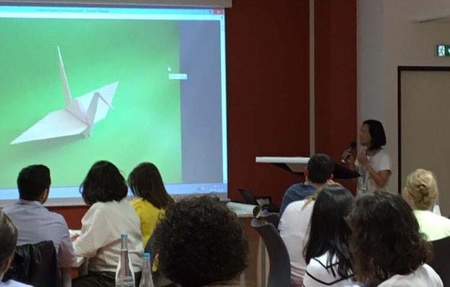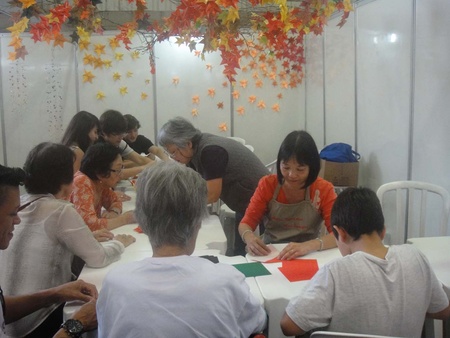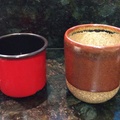“Origami is a means of communication and expression; it's a universal language that brings together different generations and peoples around the same activity.”
—Mari Kanegae
Toshi came to Brazil on a paper bird.
When her granddaughter, born in the oh-so-far-off city of Londrina [the second largest city in the Brazilian state of Paraná], went to Japan to meet her, she realized that she would have to renounce words to communicate with the little girl. She folded a tsuru. She most certainly couldn't have imagined that the bond then created would cross oceans and time itself.
More than two decades went by. Mari, by then an artist, had forgotten about that episode. Throughout the years, she had continued to acquire sparse experiences with the folds, until one day they revealed the strongest thing she carried inside her: the desire to create links between people. She decided to delve deeper into the art of origami in her grandmother's country. That was the tsuru yearning to make its way back.
Over there, in the oh-so-far-off Japan, fate set up a meeting between her and the great master Toyoaki Kawai. After following his practice for a year, she was able to capture the subtleties of both origami and what it meant to be an artist. “I learned with him that an origamist has to be a good observer. One must look at everything around us, especially nature. And then we have to interpret it all through paper folding.
She would return more times to meet with other masters, never putting an end to this coming and going. Even today, she flies over the oceans with groups of Brazilians to guide them along the paths of origami. The tsuru would never again quiet down. She has also visited other places around the world to learn and to teach. “My story has no end. I go on learning; teaching and learning.
A quick search for her achievements shows right away the importance she has acquired in the promotion of this kind of art in Brazil. Individual and collective works bearing her name are scattered throughout Brazilian and Japanese cities. She has either authored or co-authored origami books in Portuguese. She gives corporate lectures, leads workshops, and is often seen on television. The Internet is filled with references about her.
Notwithstanding the repercussion of her efforts, it's in her close contact with students that her work is built and gains consistency. Her classes, which she divides among her atelier, the Cultural Alliance Brazil-Japan, and volunteering, go beyond the teaching of the techniques. They satisfy the continuous quest to convey origami's most profound meanings. For instance, patience and perseverance, which are made manifest in the folds while slowly flooding the whole being of the practitioner.
From the bonds developed in the classroom, emblematic collective works have emerged. Under her supervision, the Origami Study Group ([Port. acronym] GEO), formed by alumni, has created artworks with remarkable characteristics.
“Japanese Immigration in Brazil” depicts scenes from the daily lives of Japanese immigrants in the early twentieth century, showcasing some of their influences on Brazilian society. After touring Brazilian cities, the exhibition traveled to Japan, where it was viewed by thousands of visitors. From the artist's standpoint, her major success was, first and foremost, having brought people together around a common interest in the process behind the creation and execution of the artworks. Next, it was touching the sensibility of those who saw themselves portrayed in the works, like the immigrant who laughed at the chickens that stirred up old memories, and, at the other end, of those who had no concept of the represented reality. For instance, the elderly wheelchair user who, in Japan, was moved when she became aware of the difficulties experienced by her fellow citizens overseas.
The artwork “Origami Carnival,” created by the same group as part of the Japanese immigration centenary celebrations in 2008, required a huge collective effort. Composed of thousands of pieces, it faithfully renders a parading samba school with “Brazil” as its theme and with each section representing the country's various regions. It took ten years to be completed.
These are just examples of a story driven by encounters between people, generations, and cultures. A story that deserves to be made known because it amply shows what it's like to preserve roots and adapt them to different times and places. “Like eating onigiri farofa ” she sums up.
With her almond-shaped eyes and undisguised warmth, Mari goes on creating links and giving new meanings to the tsuru.
The tsuru is Nikkei.
Mari is Nikkei. She goes through life facing the vicissitudes of having inherited an ancestral culture while living in another. Having embraced in herself the coexistence of different values and customs, her origami artwork harmoniously syncretizes this duality while transforming the feeling of being neither here nor there into the feeling of being both here and there.
* * * * *
Our Editorial Committee selected this article as one of her favorite Nikkei Roots: Digging into Our Cultural Heritage stories. Here is the comment.
Comment by Célia Sakurai
For the most part, roots are buried, not dead. They're responsible for seeking nutrients that give the plant life. The visible part is revealed by the leaves, flowers, fruits. We can make an analogy to cultural issues. The roots aren't dead; they get renewed, they give life, they provide color. The showcased articles illustrate the variety of fruits that the roots can give birth to. These are four stories that attempt to bring to light the strength of the presence of our Japanese roots – changing, being renewed, creating without abandoning the source that inspired them. Possibly in the remembrances of characters like Ryu Mizuno, the moti cookies, the music, and paper folding.
Heriete Shimabokuro Takeda's “Crossing the World” was the selected text because it ably synthesizes how roots of Japanese origin remain on the move, searching for local nutrients to give new life to a traditional art form like origami. Brazilian artist Mari Kanegae succeeds in blending the art of a Japanese grandmother with Brazilian themes like the samba school. Heriete Takeda presents the artist's trajectory with the intent of demonstrating that the new and the old coexist harmoniously, inspiring and suggesting new trends without discarding ancestral traditions.
© 2018 Heriete Takeda









